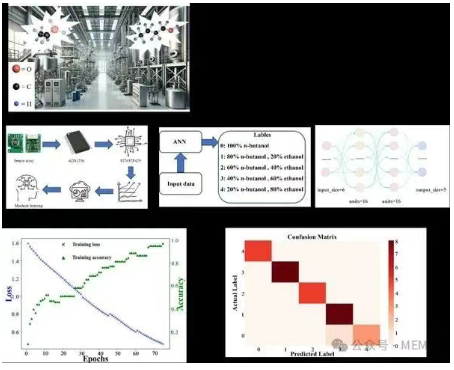Hubei Ruiyuan Electronic Co.,Ltd.
Hubei Normal University Makes Breakthrough in Gas Sensor Technology
Release time:
2025-07-19
Recently, Dr. Xiaobing Hu's team at the School of Materials Science and Engineering, Hubei Normal University, has made a breakthrough in gas sensor technology. Their research, entitled 'Synergistic CdS/Ti₃C₂Tₓ MXene Heterojunction for Ultrasensitive and Selective n-Butanol Detection,' has been published in Chemical Engineering Journal (CAS Q1 TOP journal, 2025 IF: 13.2).This study constructs a novel heterojunction sensor via hydrothermal synthesis and integrates machine learning, providing an efficient solution for real-time n-butanol detection in industrial safety and environmental monitoring.
As a key industrial chemical, n-butanol leakage or excessive emissions pose serious health risks, including liver damage and neurological disorders.Current detection methods (e.g., gas chromatography, mass spectrometry) suffer from high costs and operational complexity, while conventional metal-oxide semiconductor sensors face limitations in sensitivity and selectivity.Therefore, developing novel gas sensors with high sensitivity and user-friendly operation holds significant practical importance.
Hubei Normal University's team led by Xiaobing Hu synthesized CdS/Ti₃C₂Tₓ MXene heterojunction nanocomposites via a facile hydrothermal strategy.This heterostructure leverages the synergy between Ti₃C₂Tₓ nanosheets and CdS nanospheres, achieving a specific surface area of 42.3 m²/g (4× higher than pure CdS), which significantly increases gas adsorption sites.Tests show the optimized sensor achieves a response of 23.1 to 50 ppm n-butanol at 210°C, with fast response/recovery times (10 s/9 s) and a low detection limit (1 ppm), outperforming other CdS- or MXene-based sensors.This study not only overcomes the limitations of conventional sensors through heterojunction engineering, but also integrates machine learning with sensing technology, providing an interdisciplinary innovation for gas detection.

The paper's first author is Dr. Xiaobing Hu from the School of Materials Science and Engineering at Hubei Normal University, with the Hubei Key Laboratory of Optoelectronic Materials and Devices serving as the primary affiliation.This work was assisted by graduate students Kaibin Zhang and Ronglong Li, Dr. Dongxia Tian and Dr. Yi Cao from the School of Materials, and Prof. Zhigang Zhu from the University of Shanghai for Science and Technology.This research was supported by the National Natural Science Foundation of China (Grant Nos. 52303314, 12304041) and the Hubei Provincial Natural Science Foundation (Grant No. 2023AFD028).
Citation: China Electronic Components Association.
Retrieved from http://www.ic-ceca.org.cn
Online Message

